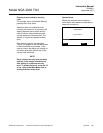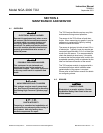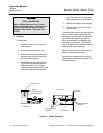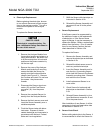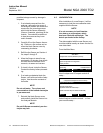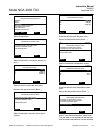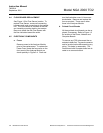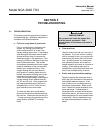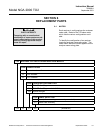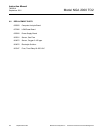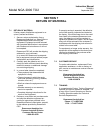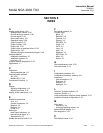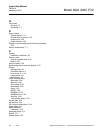
Instruction Manual
760008-A
September 2001
Rosemount Analytical Inc. A Division of Emerson Process Management Troubleshooting 5-1
Model NGA 2000 TO2
SECTION 5
TROUBLESHOOTING
5-1 TROUBLESHOOTING
The following provides a short list of common
troubleshooting tips. Additional information is
contained in the Platform Manual.
a. Failure to purge down to ppm levels
Prior to conducting any changes to the
system, try running a quick start se-
quence (see section 3.4) to see if the
oxygen reading goes lower. If the reading
does decrease, the sensor has not been
allowed sufficient time to consume the
dissolved oxygen in the electrolyte. If the
reading continues to read high a leak may
exist in the sample lines. The number
one problem associated with trace oxygen
analyzer installation is the occurrence of
leaks in your sample plumbing. If the
oxygen reading will not come down to
ppm levels or is reading higher than ex-
pected, the sample plumbing prior to the
instrument may have a leak. A quick
check can be conducted by observing the
oxygen reading at two different flow lev-
els; 0.5 and 2.0 scfh. If the oxygen read-
ing drops significantly when the flow is
increased from 0.5 to 2.0 scfh, this is a
good indication that a leak exists.
To check for leaks prior to the sensor,
disconnect the Analyzer Module and cap
the inlet line. Pressurize the inlet line to 5
- 10 psig and check all connections with a
soapy solution (SNOOP
®
) to identify
leaks.
WARNING.
SENSOR DAMAGE
Do not pressure check the sample line
with the sensor connected. Over-
pressurization of the sensor can result in
damage.
b. Flow sensitivity
Check to make sure that your vent line is
not blocked. If you see a rise in reading
with an increase in flow, you may be over-
pressurizing the sensor due to a blocked
vent. Since the sensor is a partial pres-
sure measuring device, an increase in
sample pressure will cause an increase in
reading. If the reading drops with in-
creased flow, conduct the leak check out-
lined in the troubleshooting tip above.
c. Erratic and very insensitive readings
Check to see that the electrolyte level is
within the limits indicated on the reservoir.
Add distilled water as required. If the
level is within limits, the electrolyte may
have been contaminated. Refer to sec-
tion 4.2 above for proper procedure to re-
place electrolyte. If replacement of
electrolyte does not improve the perform-
ance of the sensor, the sensor may have
been damaged due to over-pressurization
or poisoning. Sensor replacement may
be required as described in section 4.3
above.



